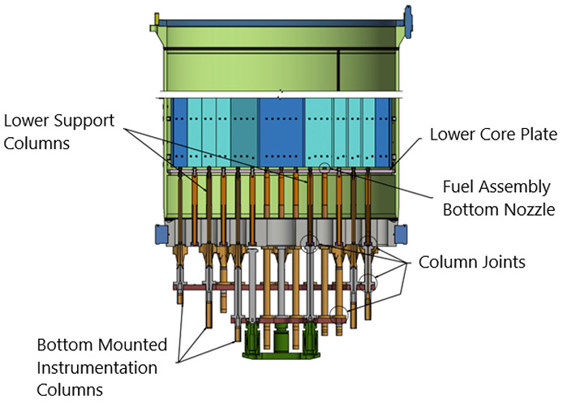Background
Instances of flux thimble tube wear and leakage observed in operating Westinghouse designed reactors with bottom mounted instrumentation have been attributed to flow-induced vibrations in the lower internals support column area. As a result, the U.S. Nuclear Regulatory Commission (NRC) issued Bulletin 88-09, “Thimble Tube Thinning in Westinghouse Reactors,” which instructs affected utilities to establish and implement inspection programs to periodically confirm thimble tube integrity. In response to the recognized potential wear issue, Westinghouse has developed a flux thimble tube design upgrade to increase thimble tube life and integrity to assure safe plant operation.
The design upgrade consists of applying a thin layer of chrome plating along the length of the flux thimble that, due to flow-induced vibration, sustains the maximum wear. This high-wear region is located between the bottom nozzle of the fuel assembly and the bottom of the reactor vessel. Installation of chrome-plated flux thimble tubes does not require additional plant modifications and does not impact the incore detector or detector drive system.

General Arrangement of Reactor Lower Internals

Chrome Plated Flux Thimble
Description
The flux thimble tube is chrome plated in the region where the wear due to flow induced vibration occurs. This region encompasses the lower internals instrument support columns, the lower core plate, and the fuel assembly bottom nozzles. The starting point of chrome plating is just above the fuel bottom fuel nozzle and extends down to just outside the bottom of the reactor vessel. The chrome-plating material is at least 99.9% chromium with < 0.05% cobalt content.
Benefits
The chrome plating reduces flux thimble wear, thereby extending the life of the flux thimbles by at least a factor of two to three when compared to conventional flux thimbles.
This reduces maintenance costs and supports as-low-as-reasonably-achievable (ALARA) objectives by reducing personnel dose as a result of:
- Increased interval between flux thimble eddy current inspections (a contracted inspection costs ~$150,000 - $200,000 and the dose per inspection ranges from 100-150 mrem)
- Increased interval between thimble replacements (or eliminated replacements), which also saves space in the spent fuel pool
Experience
Westinghouse has installed chrome-plated flux thimbles in 22 units in the United States and abroad. Eddy current inspections of in-service chrome plated flux thimbles confirm that they have extremely high resistance to wear. Several utilities have used this data to justify increasing the interval between flux thimble eddy current inspections.



